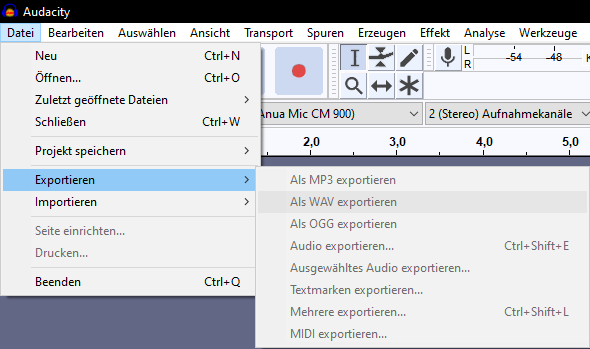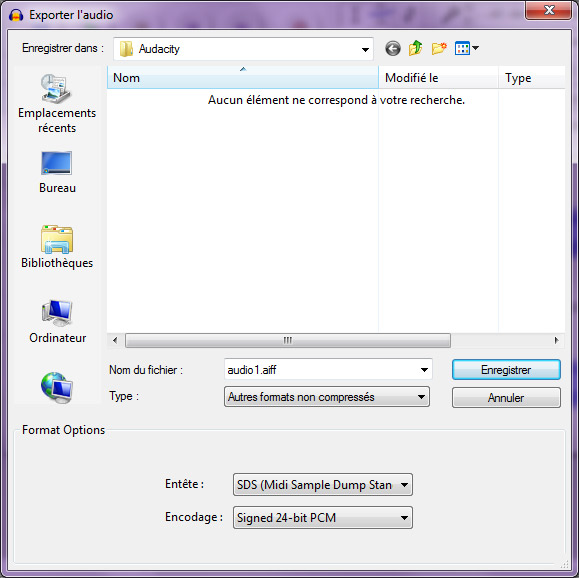

#Aup to m4a converter mac#
The other programs that open M4A files are Microsoft Zune, Elmedia Player (for Mac users), Apple iTunes, Rhythmbox (for Linux users), and iPad.
#Aup to m4a converter windows#
Some of them are Winamp, VLC Media Player, Windows Media Player, and QuickTime. There are several programs and applications out there that support the playback of M4A files. The simplest way is to use an Apple voice recorder or convert another audio format into M4A. You can create and open an M4A file in many ways.
#Aup to m4a converter how to#
How to create and how to open an M4A file M4A files have additional enhancements that boost the sound quality. It is easy to edit and transfer M4A files because it is designed to be an unprotected audio file format. Some of the benefits or advantages of using M4A are: That is in addition to the fact that it is a better competitor to MP3. M4A was developed to help you store a wide range of file types, such as audiobooks, podcasts, and songs. It is a type of audio file type that is encoded using Advanced Audio Coding (AAC) or Apple Lossless Audio Codec (ALAC). Please use lossless audio formats whenever possible.M4A stands for MPEG A Audio. Sample rate and bit depth conversions are using the high quality We support a wide range of input and a limited selection of output file formats. Warnings will be displayed in the application and are also exported It is also possible to setup Warnings for quality control or asĪlerts to manually check problematic segments in your audio:įor example, you don't want a MaxMomentary loudness >= -19 LUFS or The exact file format is the same as in our In machine readable JSON, in YAML, or in a human readable text format. Statistics can be exported as files (manually or automatically) Statistics about your input audio signals (SNR, Background and Signal Level) and much more. It also shows how much our Adaptive Leveler changes your levels (Gain mean, min, max), ) and certain regulations for commercials (Max Momentary, Max Short-term Loudness - see Section 2.2). (Program Loudness, Maximum True Peak Level, LRA - see They can be used to check compliance with Output file options, intros/outros, warnings, hardware settings, etc.)Īudio Processing Statistics of input and output filesĭisplay details about what our algorithms are changing in your files. The combined progress is shown in the application.Īll your current settings (audio algorithm parameters, Just drag and drop audio collections into the program window andĪll files will be processed in parallel with your current settings.ĭuring processing, the progress and status of all individual files and

Parallel Task Queue with configurable CPU, RAM and disk usage. The Auphonic Leveler Batch Processor includes a Identify power line hum and all its partials.Īfterwards the partials are removed as necessary with sharp filters.Īn adaptive High Pass Filter cuts unnecessary and disturbing low frequencies,ĭepending on the context (speech, music or noise). In automatic mode, a classifier decides if and how much noise reduction Our Noise Reduction algorithms remove broadband background noise in audio files with slowly varying backgrounds.įirst the audio file is segmented in regions with different background noise characteristics, then a noise print is extracted in each region True peak level and ensures compliance with the selected loudness target. Is used to limit the final output signal to the selected maximum The loudness is calculated according to latest broadcast standards ( ITU-R BS.1770)Īnd Auphonic supports loudness targets for television ( EBU R128, ATSC A/85),Ī True Peak Limiter, with 4x oversampling to avoid intersample peaks,

Processed files have the same average loudness. Global Loudness Normalization calculates the loudness of your audio andĪpplies a constant gain to reach a defined target level, so that all This algorithm was trained with over three years of audio files from our Web Service and keeps learning and adapting to new data every day. Most suitable for programs, where dialogs/speech is the most prominent content: podcasts, radio, broadcast, lecture and conference recordings, film and videos, screencasts etc.Background segments (noise, wind, breathing, silence etc.) won't be amplified.Music segments are processed with care: the overall loudness will be comparable to speech, but the natural dynamics are not changed as in speech segments.Loudness differences between speakers are corrected and dynamic range compression is applied.Music, background and speech segments are classified.Our Adaptive Leveler analyzes the content of audio files using machine learning techniques and is capable of balancing loudness variations between segments in one file: The following algorithms are included in the Auphonic Leveler Batch Processor:


 0 kommentar(er)
0 kommentar(er)
